Northern Pine Snake - September 2003 Species of the Month
|
If unexpectedly encountered on the trail or in the
woods, this large, white-and-black patterned snake would most likely vibrate
its tail, hiss loudly, and then try to escape. Though its bold appearance
and actions may fool or scare some people, this particular species of
snake is not venomous. In fact, it is harmless to people and is a beneficial
predator in nature.
|
|
|
The Northern pine snake (Pituophis melanoleucus
melanoleucus) is a threatened species in New Jersey and was the September
Species of the Month. The designation was part
of a yearlong program to commemorate the 30th Anniversary of the New
Jersey Endangered Species Conservation Act and the formation of DEP's
Endangered and Nongame Species Program (ENSP).
|
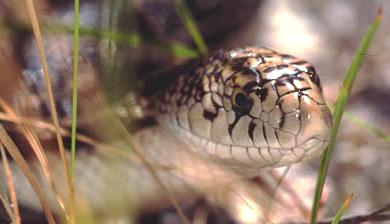 Northern Pine Snake
Northern Pine Snake |
|
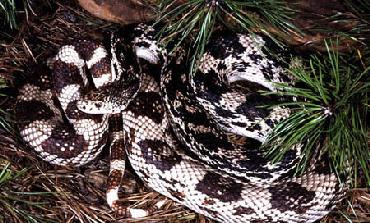
Coiled Northern Pine Snake
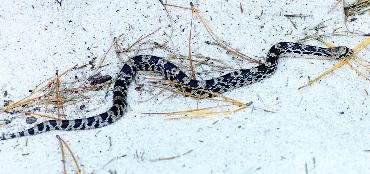
Northern Pine Snake on sand
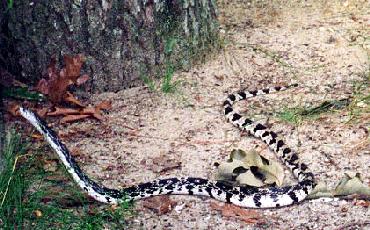
Northern PIne Snake
|
In Search of a Secretive Snake...
- There are four types of pine snakes that
can be found in the United States. The northern pine snake is
found in the Northern and Eastern-Central regions of the country,
in areas with sandy soils and dry upland forests. The population
distribution of this pine snake is spotty and all indications
suggest that pine snake abundance is decreasing throughout the
Northeastern region.
- The New Jersey Pinelands may provide residence
for some of the largest populations of pine snakes in the Northeast,
but even in the protected Pinelands this species may be at risk.
- The northern pine snake is known for being
secretive and is therefore challenging to study and detect.
This species of snake, which rarely climbs vegetation and prefers
to be on the ground, has the ability to tunnel underground and
excavate its own nests, summer dens and places to hibernate.
Therefore, scientists believe that it prefers the more pliable
sandy soils and forested areas of the Pinelands.
- The northern pine snake populations in
New Jersey have been affected by a loss of habitat due to development,
illegal collecting (due to its popularity as a pet), and other
more individualized behavior such as the thoughtless killing
of snakes by hikers, automobile drivers and users of off-road
vehicles.
- Department biologists in the Endangered
and Nongame Species Program have created a technique for
using land cover and soils information to produce maps of potential
pine snake habitat. They used scientific literature, information
from pine snake experts and the DEP's
Geographic Information Systems and wildlife databases to
develop the maps. These maps, which depict potential pine snake
habitat, have been completed for the southern New Jersey Pinelands.
Biologists plan to compare known locations of pine snakes with
the mapped habitat to help refine the mapping criteria and guide
future management plans.
|
|
Northern Pine Snake – Facts
of Interest
- The northern pine snake can grow to 5 feet to 7
feet long and has a black and dull white pattern. There are dark blotches
along the top and sides of the body which are less distinct in the front
part of the body and more distinct in the hind part. The belly is white
with rows of black dots along either side.
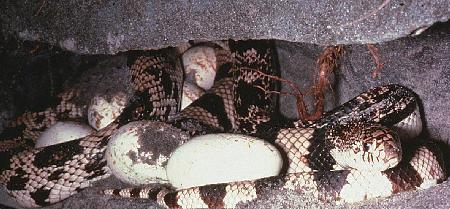
- This species of snake has a small pointed
head with a tipped snout and thick neck, which are helpful when
it moves soil around or burrows. It also has a special scale at
the front of its snout that shields its nose and protects it as
it tunnels underground. In fact, much of its time is spent hidden
underground.
- The pine snake is a nonvenomous constrictor.
It kills its prey by coiling itself around it in order to suffocate
the animal. Pine snakes are known to eat mammals as large as rabbits,
as well as small rodents and birds. They are usually most active
in early morning or late afternoon when they leave their burrows
to hunt.
- Pine snakes are egg-layers and typically
lay their eggs in underground nests that they excavate in open
sandy areas. Eggs are usually laid in mid-summer, and adult females
have the tendency to re-use their nest sites year after year.
|
| Ways You Can Help |
|
- Avoid killing a snake if encountering one in a
natural area, either when you are traveling on foot or in a vehicle.
Back away slowly and do not disturb it.
-
Anyone who is interested in reptiles and amphibians
and enjoys being outdoors can become a volunteer with the Herp
Atlas Project. Department staff and volunteers are collecting
data on the locations and abundance of all reptile and amphibian species
throughout the state. This data will be used to map the critical habitat
and distribution of these species, which will allow the agency to
better plan for the state's wildlife conservation efforts.
- Attention, observant nature lovers! Department
staff would like to learn about your sightings of an endangered, threatened or rare
species in New Jersey. To file a report of a sighting, download and
complete the Threatened and Endangered Species
Report Form. This data helps biologists and wildlife managers to
look at habitat and population trends and then develop appropriate conservation
strategies.
|
|
|
Order a
Conserve Wildlife special interest license plate for your vehicle. It's
tax-deductible, with 80% of the payment benefiting New Jersey's Endangered
and Nongame Species Program. |
|
Do you enjoy learning about New Jersey wildlife? Being
outdoors? Interacting with the public? Assisting with meaningful volunteer
initiatives? 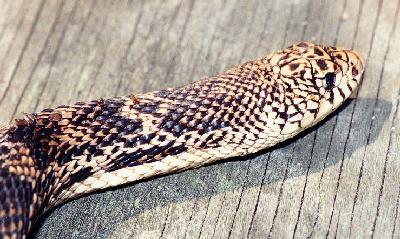 If so, join the Wildlife Conservation Corps,
the state's largest natural resource management volunteer group. Volunteer
opportunities are diverse and include lending assistance with trout stocking;
operating check stations; maintaining shooting ranges; and instructing
the public. Adults interested in public speaking are also invited to join
the Corp's Endangered and Nongame Species Program's
Speakers Bureau. The bureau provides speakers to organizations interested
in learning more about New Jersey's threatened and endangered species.
If so, join the Wildlife Conservation Corps,
the state's largest natural resource management volunteer group. Volunteer
opportunities are diverse and include lending assistance with trout stocking;
operating check stations; maintaining shooting ranges; and instructing
the public. Adults interested in public speaking are also invited to join
the Corp's Endangered and Nongame Species Program's
Speakers Bureau. The bureau provides speakers to organizations interested
in learning more about New Jersey's threatened and endangered species.
Want to learn new information quickly about New Jersey
wildlife? The Division of Fish and Wildlife offers eight E-mail "mailing
list" choices to the public. Visit the E-mail
List Subscription Page to learn more about this free service and how
to sign up.
|
|
|
| Additional
Sources of Information |
|
|